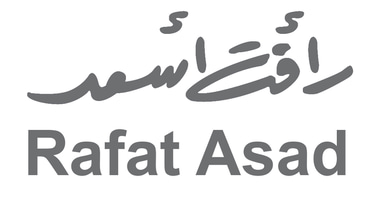Marj-Ibn-Amer-2015
Marj bin Amer
Mahmoud Abuhashhash
April 2015
Rafat As'ad returns to painting, his right field, after a relatively long break, since his exhibition "White Phosphorus" (Al-Mahatta Gallery, 2009), to resume his journey of continuous deep but subtle exploration in the landscape.
Since his first solo exhibition, "Narrative" (A. M. Qattan Foundation, 2006), which heralded the birth of an artist with qualities that marked him among his young artists peers as a painter who has something to add to the art scene in Palestine. In fact, he presented daring artworks in their compositions, materials, and colors, continuing with his subsequent works, and culminating in this current exhibition, not ceasing his engagement with the theme of the landscape.
In his exhibition, "Marj Bin Amer," Rafat presents the essence of his experience over the past ten years through artworks filled with ethereality and possessing great ability to open vast spaces for contemplation, as if he were pushing the earth to the realm of the sky or bringing the sky down to the level of the earth. It is as though the artist takes Marj Bin Amer as a visual excuse to draw from what is hidden within him in terms of feelings, images from his imagination and memory, in which the supposed boundary between the imaginary and the real, the earthly and the celestial, vanishes. This part of Palestine, which he only physically encountered in a real visit in 2000, is captured in a fresh style, walking with the expertise of a connoisseur along the cautious and equivocal edges of both impressionism and abstraction, without firmly placing his feet in either one."
“…vast fields of wheat under troubled skies… these canvases will tell you what I cannot say in words…”
(Vincent van Gogh, in a letter to his brother Theo, 1890)
Nicola Gray
April 2015
In the history of art, whether western or eastern, and especially for its painters, the ‘landscape’ has been a subject in some form since a brush was first applied to a surface to make a ‘picture’. The painters’ intentions, however, were rarely to simply observe and celebrate nature’s wonders, and in Palestine to paint the ‘landscape’ means engaging with much more than a simple observation of natural beauty.
In another letter, Van Gogh writes of being “quite absorbed in the immense plain with wheat fields against the hills, boundless as a sea” near the town of Auvers in northern France where he was living. Rafat Asad, in this new series of paintings, has also been absorbed in an immense plain, the wide fertile valley of Marj Ibn Amer that lies between the hills of Galilee in the north and the Nablus hills and the area around Jenin in the south. It is a landscape the artist has been familiar with looking at for much of his life.
Yet the boundary-less infinity of space and sky that is conveyed in these paintings hovers over a site of division. The 1949 Green Line, and now the separation-walled northern ‘border’ of the West Bank, cut right through the valley, resulting in the creation of an unattainable landscape the artist can only experience as a vista to a far horizon.
Conscious of identifying with the land and its meanings since he was a child and a young student of art, Rafat shows us in these recent paintings a unique and personal interpretation of engaging with the idea of ‘landscape’ and makes subtle reference to the fragmentation of Palestine. The colours, space and light in these spectacular vistas dissolve into the atmospheric haze; there is a dizzying sweep over the land to the distant horizons, a sense of space and altitude that seems to invite us to take flight over the fields below. In the West Bank hills, there are other locations where the vistas across open space have led to them becoming iconic sites of significance. Looking west from certain places in Ramallah on a clear day, the glitter of the Mediterranean can be seen, only a short drive away but unattainable to most; the village of Al Ubeidiya, near Bethlehem, is now the only place where many Palestinians can see Jerusalem and the Dome of the Rock glinting in the sun. Looking across Marj Ibn Amer, we look to the north and the usurpation of its fertile agricultural land.
Rafat’s paintings are deceptive in their apparent celebration of light and air, the colours of the seasons, the patterns of the fields, the gentle slopes of the hills, the edgelands where town meets field; they hide more than they reveal. They are not painted en plein air as Van Gogh did, and if the separation wall is visible in any of these actual views, the artist has not included it. They are an amalgam of the artist’s imagination and memory with the art of painting and the illusionary but liberating space it can so brilliantly create.
Studied fine art at Bournville School of Art, Birmingham, UK; Winchester School of Art, UK; and Mills College, Oakland, California. A freelance artist, writer, editor and sometimes a curator, normally based in the UK. A member of the collective of co-ordinators of the Braziers International Workshop in the UK from 1996-2005. A curator (2006 and 2010) and jury member (2012) for the Young Artist of the Year Award for Palestinian artists (an A M Qattan Foundation project centred in Ramallah), she has been collaborating with Palestinian artists and art and cultural organisations on artists' residencies, exhibitions and publications since 2002. Currently manages and edits the journal Third Text's website content and its open-access, web-based journal 'Online' and the online Forums (www.thirdtext.org/online, www.thirdtext.org/forum)
Rafat Asad
+970-59 987 0421
contact@rafatasasd.com
© 2024. All rights reserved.
